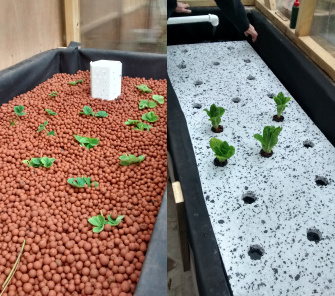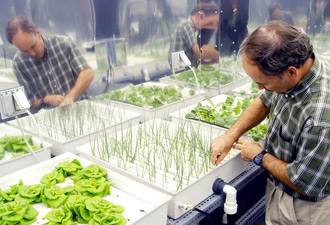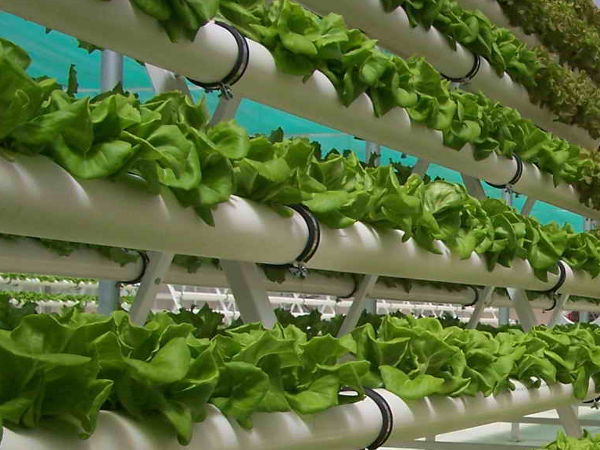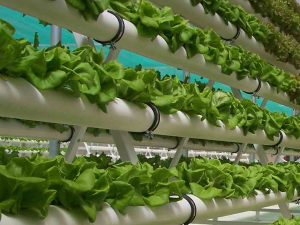“Hydroponics can generate food crops from barren desert sand and desalinated ocean water, in mountainous regions too steep to farm, on city rooftops and concrete schoolyards and in arctic communities.” – University of Arizona
Contents
What is hydroponics?
Hydroponics is growing plants in a non-soil medium, using water with added nutrients. There are different options, such as:
- Deep water culture / Raft system: a ‘raft’ with holes in floats on a tank of water containing nutrients. Plant roots extend into the water through holes in the raft.
- Media bed: a medium such as clay pebbles, sand, gravel etc. is used to support the plants, but they don’t get anything from the medium, which is pH neutral. A media bed tends to be used for larger plants than a raft system. Nutrient solution is pumped from a separate tank (either to flood the medium temporarily, to flow through the medium, or to a drip-feed system), or could even be delivered without pumps, using a series of wicks that the nutrient solution can move through via capillary action.
- Nutrient film technique (NFT): nutrient solution flows through plastic pipes (could be drainpipes or two gutters fixed together, or it could be an off-the-shelf system). Holes are cut in the top of the pipes so that plants’ roots can be immersed in the nutrient solution.
In all three systems, the plants sit in ‘net pots’ (see photo). A piece of coir mat sits in the net pot – a seed germinates on the coir and the roots grow through the bottom of the net pot. Net pots are either pushed into the clay pebbles, or they fit into the holes in the raft or pipe.

‘Aeroponics’ is a higher-tech system where roots are suspended in air, and are misted with nutrient solution via pumps and timers.
History
The legendary, ancient Hanging Gardens of Babylon were said to have incorporated what we would call hydroponics. Much more recently, small-scale experiments aimed at growing plants in water rather than soil have been carried out since the 17th century, a breakthrough coming in Germany in the 19th century when Sachs and Knop discovered that plants need mainly nitrogen, phosphorus and potassium (NPK) to thrive, and developed a nutrient formula based on these elements. Hoagland added micronutrients such as iron, magnesium and sulphur in the 1920s.
In the 1970s it was discovered that the cannabis plant grew in a hydroponic system, and that indoors was a good place to grow plants that you didn’t want anyone to know about. It resulted in a boom in the hydroponics industry. More recently, NASA has contributed to development in hydroponics for growing food plants in space.
A lot of the lettuces and tomatoes in supermarkets come from big hydroponic warehouses in the Netherlands, as do a lot of cut flowers.

What are the benefits of hydroponics?
Personal
Gaining any craft or growing skills can help meet your and your family’s needs, save you money and bring a lot of satisfaction and pleasure.
Expensive crops can be intensively grown using hydroponics, therefore saving quite a bit of money.
Tests have shown similar nutrient levels in food grown hydroponically or in soil – however, plants grown hydroponically are subjected to less stress than plants grown outdoors, which results in lower antioxidant levels because they don’t have to develop natural defences against pests.
Environmental
- Can be stacked / layered / vertical, so can produce more food from a given area.
- Uses less water for irrigation – it’s recycled, in a closed loop.
- Extends the growing season, again producing more food from a given area.
- Reduces the need to transport food around the world.
- Doesn’t need pesticides.
- Can be used to grow plants in places where soil would be too heavy – for example in roof gardens.
- Can grow food where there’s no soil, for example in the desert – especially in combination with desalination of seawater, ideally with solar. It’s being tried in Chile, in the Atacama desert, where it virtually never rains. They use nets / mesh to catch / condense water from moisture in the air, then funnel it down to a collection point for the hydroponic systems.
But there are disadvantages too:
- Uses synthetic things like plastic and polystyrene instead of just soil. (although they can be second-hand / recycled).
- Uses mainly synthetic fertilisers / nutrients, which involve energy use, industrial processes and pollution; organic hydroponics is possible but more difficult because organic nutrients tend not to be water soluble (see ‘what can I do?’).
- Needs more resources – buildings, electricity etc. (although that’s true of a greenhouse).
- Doesn’t create an ecosystem like an allotment, garden or smallholding does, so doesn’t contribute to ecology / habitat.
- Based on human technology rather than nature – nature knows best what to give plants (and ultimately us) via the soil and the ecosystem in it.
Democracy / decentralising power away from corporations
Providing food (including fish, with aquaponics) for ourselves in communities helps prevent extraction, decentralises power away from corporations (which makes it more difficult for them to corrupt democracy) and democratises work.
Community / collapse preparation
Exchanging home-grown produce (etc.) strengthens community bonds, and in case of any kind of collapse scenario (broken supply chains, environmental destruction, financial crash, war, civil unrest etc.), we’re going to have to look after ourselves in our communities, and so the more people with useful skills the better.
Hydroponics may be needed if ecology is damaged and soil is eroded so much that they can’t support us any more.
Here’s more on the basic principles and advantages / disadvantages of hydroponics from the University of Arizona.

What can I do?
Starting off / getting a system
Small hydroponic systems can be housed in a greenhouse or indoors. Whatever system you use, you can buy off-the-shelf (or second-hand) kit, or you can build your own bespoke system, using basic DIY and plumbing supplies that are widely available. The only specialist equipment required are a pumping system and air stones that can be found in any aquarium shop.
If you decide to build your own, there are plenty of books, websites and online videos that will show you exactly how to do it, depending on what type of system you choose. You’ll need a nutrient tank, delivery system and housing for plants – either in pipes, raft or a medium-filled tank. Interviewee Joe built his own system with reclaimed materials for £600 in total, including £200 of epalyn liner (25-year guarantee). Pond liner from a garden centre is much cheaper. He aims to produce around £300 worth of food per year. The sophistication and permanence of your system may depend on how long you intend to stay in your property, but a productive system will pay for itself reasonably quickly.
For a deep water culture / raft system, polystyrene isn’t the most environmentally-friendly material for the raft, but only one sheet is required for a DWC bed, and it’s both buoyant and easy to cut through to insert the net pots. A sheet will hopefully last more than two years – you just have to periodically wipe algae from the surface.

Nutrients
Soil is the medium that most plants have evolved to live in. Soil is a living medium, and all the microorganisms living in it are constantly making nutrients available for plants. This doesn’t happen in hydroponics, and so all the nutrients, including micro-nutrients, must be added to the nutrient mix, apart from carbon, oxygen and hydrogen that can be absorbed from the air and water.
In order for nutrients to be useful in a hydroponic system, they must be water soluble, for obvious reasons. This rules out a lot of organic materials because they tend not to be water soluble. There are ways round this if you want to grow hydroponically but with organic, non-synthetic nutrients – see below. Plants grown hydroponically need mainly nitrogen, phosphorus and potassium (NPK), the same as plants grown in soil. Manufactured hydroponic nutrients contain mainly NPK, but with micronutrients like calcium, magnesium and sulphur added.
The nutrient that is most likely to be deficient in a hydroponic system is nitrogen, in the form of nitrates. It’s essential for hydroponic growers to be able to notice the signs that their plants aren’t getting enough nitrogen.
Plants will only be able to absorb nutrients from the solution within a certain range of pH values, so it’s essential to check pH – otherwise, even if all the required nutrients are there, the plants won’t be able to access them.
The nutrient delivery system can be automated cheaply, so that you can go on holiday – otherwise your system will probably need around 5-10 minutes of your time every day to make sure that it’s working properly.
Growing hydroponically
It’s a good idea to attend courses and read as much as you can before you start – there’s a lot that can go wrong. But if you enjoy looking after plants, it can be very exciting to see them growing in a different way, with you in complete control of all inputs. The plants will be much more dependent on you though – you have to be around to look after them.
It can be productive too. In media beds or deep water culture, root systems don’t need to spread laterally to search for nutrients, so they tend to grow straight down. This means that the usual rules for spacing in soil become irrelevant – even quite large plants like spinach can grow well within 5cm of each other. You can fit a lot more plants into the available space. You can’t grow root crops though, as they’ll be prone to rotting.
There are natural ways to raise the temperature in a hydroponic greenhouse – for example by introducing a compost heap or allowing chickens to roost at night (as long as the plants are growing high enough that the chickens can’t eat them). Both these things could raise the average temperature by a couple of degrees, but they could also introduce pests.

Organic hydroponics and aquaponics
There are organic purists who say that hydroponics can’t be organic, because organic growing involves feeding the soil, not the plant, and indeed, in most countries it’s not possible for hydroponically-grown food to receive organic certification for just that reason. But certification is much less important than attempting to minimise the ecological damage that our food industry causes – it’s possible to grow hydroponically using natural rather than synthetic feeds, and pesticides are (often) not used anyway. So let’s focus on that – how to feed plants without soil, but also without the pollution, resource use and environmental damage involved with the production and distribution of synthetic chemicals.
Very little is available in the way of natural feeds, because organic compounds are generally not water soluble, which is of course essential in hydroponics. Another process has to be introduced into hydroponics when using natural / organic nutrients – microorganisms have to break down the insoluble organic material into soluble mineral ions that can be taken up by plants via the water. This happens naturally in soil, but in hydroponics, you have to make it happen. You can buy beneficial microbial products that are added to the plant medium and/or to the nutrient solution, and will do the conversion for you. This makes ‘organic’ hydroponics trickier than hydroponics using synthetic nutrients – you’ll need to be more careful with aeration and not overwatering, because the beneficial microbes will need a constant supply of oxygen. Also, you won’t want to use pH-altering products in an organic system, as they’re synthetic, so the pH will have to stabilise on its own, making the system less controllable by you.

Aquaponics is a combination of hydroponics and aquaculture (fish farming) – the fish live in the nutrient tank. The processes that occur in soil also occur in aquaponics – you can feed the fish organic material and their waste will feed the plants. The ammonia in the fish waste is one step away from what’s required by the plants, as long as the necessary microbes are present in the medium to convert the ammonia to soluble nutrients, which are absorbed by the plants. Not only is there more nutrient recycling but you can also harvest fish as well as fruit and veg, and the water gets cleaned for the fish at the same time.
There’s more room for error in aquaponics, as if too much ammonia is returned to the fish tank, the fish can die. There’s lots of troubleshooting information about this online. It’s probably best to master hydroponics first before introducing the fish.
Thanks to Joe Tucker for information.
Further resources
- Complete Guide for Growing Plants Hydroponically (pdf)
- Totally Organic Hydroponics (pdf)
- University of Florida: how to build a floating hydroponic garden
- University of Hawaii: small-scale lettuce production with hydroponics or aquaponics
- Instructables: plans for several DIY hydroponics projects



3 Comments
Hello.
I would like to know your basis/bases for this #6 disadvantage: “tests have shown similar nutrient levels in food grown hydroponically or in soil, but plants grown hydroponically are subjected to less stress than plants grown outdoors, which results in lower antioxidant levels because they don’t have to develop natural defences against pests”
My extracts from hydroponically grown plants were observed to have very low antioxidant activity. I am curious if I made mistakes during the experiment or this is indeed not a surprising result.
Respectfully,
Hazel – I’ll try to get a hydroponics specialist to respond, but this seems to be the most quoted research on antioxidant activity in hydroponically-grown plants – https://www.sciencedirect.com/science/article/pii/S0308814610005157.
It says that antioxidant activity was higher in hydroponically-grown plants than those grown in soil – in which case, we’ll need to change the article.
But did you mean to say that you found high antioxidant activity, rather than low? Otherwise, unless I’ve misunderstood, you seem to be agreeing with point #6.
My results show significant drop of antioxidant activity, agreeing with the #6 statement, but most studies show an enhancing effect. I found this review (http://dx.doi.org/10.5772/intechopen.73011) stating, “Although there are diverse and contradictory opinions, the general view of researcher seems
to be that hydroponic can enhance the content of bioactive compounds,” but without much discussion about the negative effect. Osmotic stress was commonly induced to increase bioactivity.
Thanks for the prompt reply.